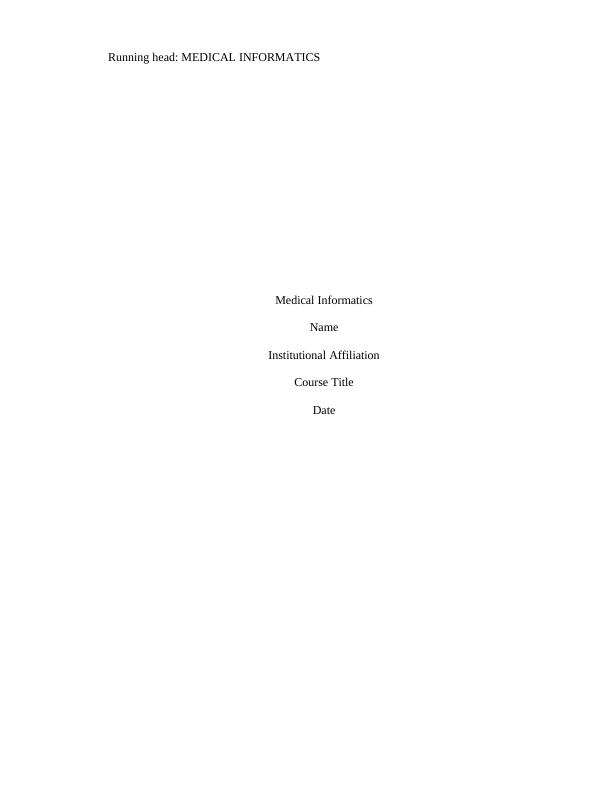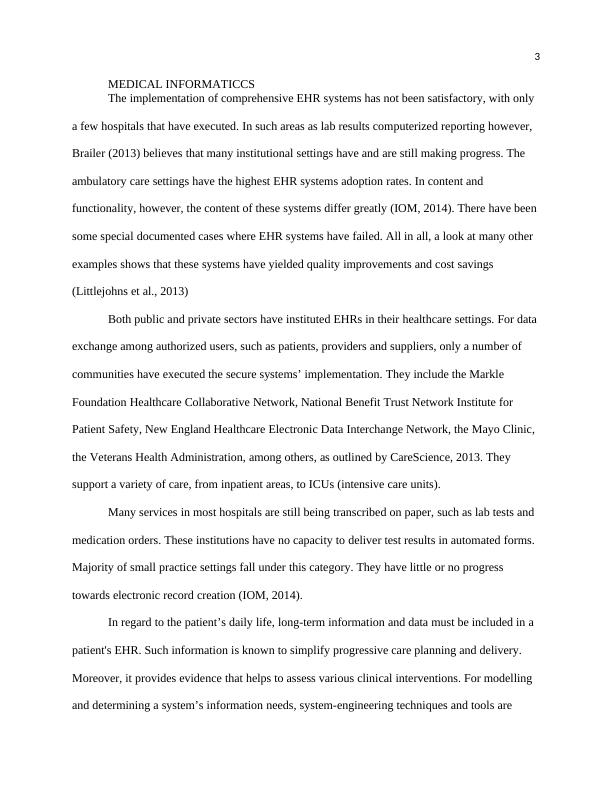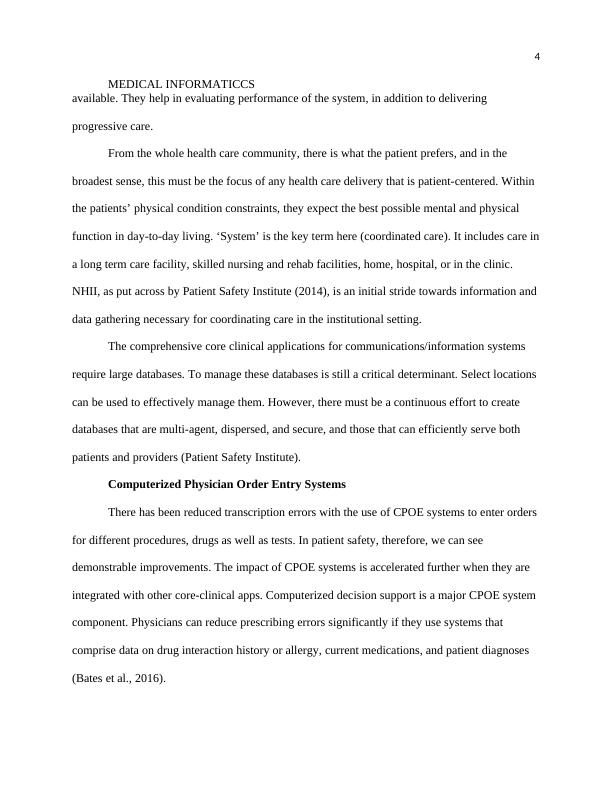Medical Informatics Assignment PDF
14 Pages4155 Words62 Views
Added on 2021-09-29
Medical Informatics Assignment PDF
Added on 2021-09-29
ShareRelated Documents
Running head: MEDICAL INFORMATICS
Medical Informatics
Name
Institutional Affiliation
Course Title
Date
Medical Informatics
Name
Institutional Affiliation
Course Title
Date

2
MEDICAL INFORMATICCS
Introduction
The speed with which a computer processes information makes it a vital tool in
information management. In all endeavors, the tool has transformed processes of handling
information and data, thus, it is the main information technology tool. Computer is known to
play critical roles in healthcare services transformation, as adjudged by consumers and
healthcare experts (Garlan et al., 2014).
In healthcare management, information technology deployment has been a game changer.
It has offered a mechanism that helps to improve reliability in the quality of healthcare. As
evidenced in this paper, medical literature as well as health information is being packaged and
efficiently delivered thanks to the vital role computer plays. With this powerful tool, we can
easily access the Internet, whose communication system is dynamic and far-reaching. On
virtually every field of endeavor therefore, the Internet influence is the most historic. In addition,
there has been an exponential increase in information sources therein.
Electronic Health Records
Most applications on healthcare communications and information technology require an
electronic capture of clinical information that is patient-specific. For the last half a decade, the
focus has been to create sustainable electronic health records (EHRs). As an essential technology
for healthcare, the Institute of Medicine (IOM) called for computer-based patient records
implementation across the nation. Throughout the healthcare system, their availability would be
instantaneous. Physicians and other health care providers can easily understand the forms in
which they are provided, even from a separate location. Nevertheless, since 1991 when the
vision was set, there has been a glacial progress rate toward its realization.
MEDICAL INFORMATICCS
Introduction
The speed with which a computer processes information makes it a vital tool in
information management. In all endeavors, the tool has transformed processes of handling
information and data, thus, it is the main information technology tool. Computer is known to
play critical roles in healthcare services transformation, as adjudged by consumers and
healthcare experts (Garlan et al., 2014).
In healthcare management, information technology deployment has been a game changer.
It has offered a mechanism that helps to improve reliability in the quality of healthcare. As
evidenced in this paper, medical literature as well as health information is being packaged and
efficiently delivered thanks to the vital role computer plays. With this powerful tool, we can
easily access the Internet, whose communication system is dynamic and far-reaching. On
virtually every field of endeavor therefore, the Internet influence is the most historic. In addition,
there has been an exponential increase in information sources therein.
Electronic Health Records
Most applications on healthcare communications and information technology require an
electronic capture of clinical information that is patient-specific. For the last half a decade, the
focus has been to create sustainable electronic health records (EHRs). As an essential technology
for healthcare, the Institute of Medicine (IOM) called for computer-based patient records
implementation across the nation. Throughout the healthcare system, their availability would be
instantaneous. Physicians and other health care providers can easily understand the forms in
which they are provided, even from a separate location. Nevertheless, since 1991 when the
vision was set, there has been a glacial progress rate toward its realization.

3
MEDICAL INFORMATICCS
The implementation of comprehensive EHR systems has not been satisfactory, with only
a few hospitals that have executed. In such areas as lab results computerized reporting however,
Brailer (2013) believes that many institutional settings have and are still making progress. The
ambulatory care settings have the highest EHR systems adoption rates. In content and
functionality, however, the content of these systems differ greatly (IOM, 2014). There have been
some special documented cases where EHR systems have failed. All in all, a look at many other
examples shows that these systems have yielded quality improvements and cost savings
(Littlejohns et al., 2013)
Both public and private sectors have instituted EHRs in their healthcare settings. For data
exchange among authorized users, such as patients, providers and suppliers, only a number of
communities have executed the secure systems’ implementation. They include the Markle
Foundation Healthcare Collaborative Network, National Benefit Trust Network Institute for
Patient Safety, New England Healthcare Electronic Data Interchange Network, the Mayo Clinic,
the Veterans Health Administration, among others, as outlined by CareScience, 2013. They
support a variety of care, from inpatient areas, to ICUs (intensive care units).
Many services in most hospitals are still being transcribed on paper, such as lab tests and
medication orders. These institutions have no capacity to deliver test results in automated forms.
Majority of small practice settings fall under this category. They have little or no progress
towards electronic record creation (IOM, 2014).
In regard to the patient’s daily life, long-term information and data must be included in a
patient's EHR. Such information is known to simplify progressive care planning and delivery.
Moreover, it provides evidence that helps to assess various clinical interventions. For modelling
and determining a system’s information needs, system-engineering techniques and tools are
MEDICAL INFORMATICCS
The implementation of comprehensive EHR systems has not been satisfactory, with only
a few hospitals that have executed. In such areas as lab results computerized reporting however,
Brailer (2013) believes that many institutional settings have and are still making progress. The
ambulatory care settings have the highest EHR systems adoption rates. In content and
functionality, however, the content of these systems differ greatly (IOM, 2014). There have been
some special documented cases where EHR systems have failed. All in all, a look at many other
examples shows that these systems have yielded quality improvements and cost savings
(Littlejohns et al., 2013)
Both public and private sectors have instituted EHRs in their healthcare settings. For data
exchange among authorized users, such as patients, providers and suppliers, only a number of
communities have executed the secure systems’ implementation. They include the Markle
Foundation Healthcare Collaborative Network, National Benefit Trust Network Institute for
Patient Safety, New England Healthcare Electronic Data Interchange Network, the Mayo Clinic,
the Veterans Health Administration, among others, as outlined by CareScience, 2013. They
support a variety of care, from inpatient areas, to ICUs (intensive care units).
Many services in most hospitals are still being transcribed on paper, such as lab tests and
medication orders. These institutions have no capacity to deliver test results in automated forms.
Majority of small practice settings fall under this category. They have little or no progress
towards electronic record creation (IOM, 2014).
In regard to the patient’s daily life, long-term information and data must be included in a
patient's EHR. Such information is known to simplify progressive care planning and delivery.
Moreover, it provides evidence that helps to assess various clinical interventions. For modelling
and determining a system’s information needs, system-engineering techniques and tools are

4
MEDICAL INFORMATICCS
available. They help in evaluating performance of the system, in addition to delivering
progressive care.
From the whole health care community, there is what the patient prefers, and in the
broadest sense, this must be the focus of any health care delivery that is patient-centered. Within
the patients’ physical condition constraints, they expect the best possible mental and physical
function in day-to-day living. ‘System’ is the key term here (coordinated care). It includes care in
a long term care facility, skilled nursing and rehab facilities, home, hospital, or in the clinic.
NHII, as put across by Patient Safety Institute (2014), is an initial stride towards information and
data gathering necessary for coordinating care in the institutional setting.
The comprehensive core clinical applications for communications/information systems
require large databases. To manage these databases is still a critical determinant. Select locations
can be used to effectively manage them. However, there must be a continuous effort to create
databases that are multi-agent, dispersed, and secure, and those that can efficiently serve both
patients and providers (Patient Safety Institute).
Computerized Physician Order Entry Systems
There has been reduced transcription errors with the use of CPOE systems to enter orders
for different procedures, drugs as well as tests. In patient safety, therefore, we can see
demonstrable improvements. The impact of CPOE systems is accelerated further when they are
integrated with other core-clinical apps. Computerized decision support is a major CPOE system
component. Physicians can reduce prescribing errors significantly if they use systems that
comprise data on drug interaction history or allergy, current medications, and patient diagnoses
(Bates et al., 2016).
MEDICAL INFORMATICCS
available. They help in evaluating performance of the system, in addition to delivering
progressive care.
From the whole health care community, there is what the patient prefers, and in the
broadest sense, this must be the focus of any health care delivery that is patient-centered. Within
the patients’ physical condition constraints, they expect the best possible mental and physical
function in day-to-day living. ‘System’ is the key term here (coordinated care). It includes care in
a long term care facility, skilled nursing and rehab facilities, home, hospital, or in the clinic.
NHII, as put across by Patient Safety Institute (2014), is an initial stride towards information and
data gathering necessary for coordinating care in the institutional setting.
The comprehensive core clinical applications for communications/information systems
require large databases. To manage these databases is still a critical determinant. Select locations
can be used to effectively manage them. However, there must be a continuous effort to create
databases that are multi-agent, dispersed, and secure, and those that can efficiently serve both
patients and providers (Patient Safety Institute).
Computerized Physician Order Entry Systems
There has been reduced transcription errors with the use of CPOE systems to enter orders
for different procedures, drugs as well as tests. In patient safety, therefore, we can see
demonstrable improvements. The impact of CPOE systems is accelerated further when they are
integrated with other core-clinical apps. Computerized decision support is a major CPOE system
component. Physicians can reduce prescribing errors significantly if they use systems that
comprise data on drug interaction history or allergy, current medications, and patient diagnoses
(Bates et al., 2016).

End of preview
Want to access all the pages? Upload your documents or become a member.
Related Documents
Assignment Health Advancement & Promotionlg...
|5
|1076
|30
Health Information Systems: A Review of EHR, EMR, and PHRlg...
|15
|1412
|334
Nursing Experiences with EHR: Impact, Ethical Issues, and Recommendationslg...
|3
|767
|179
Medical Informatics in the United States Health Systemlg...
|8
|1320
|218
Electronic Health Record (EHR)lg...
|4
|691
|138
Nursing Informatics - Electronic Health Recordslg...
|4
|784
|339
